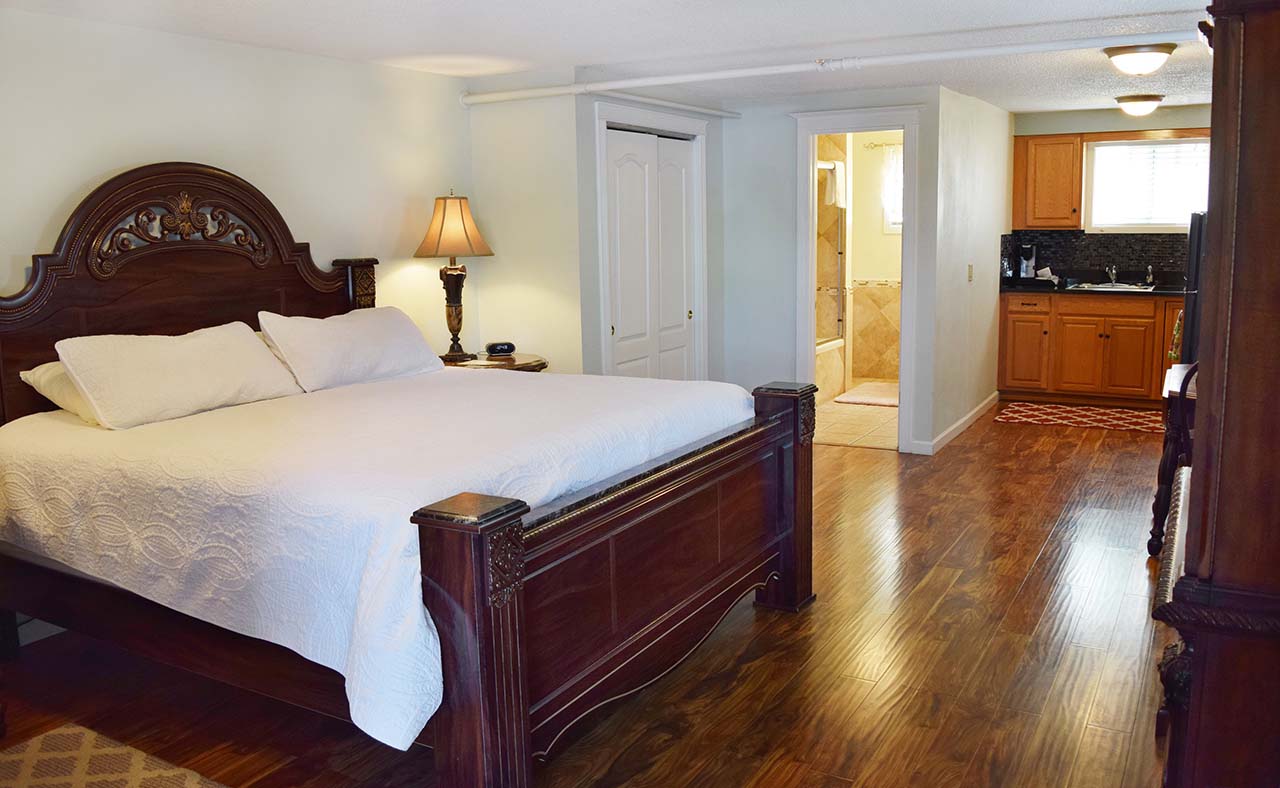
The Merchants Room
Search Rooms
Parts of the backbone of every community are the merchants. The men, and sometimes women, bring the goods and services that are needed and desired whether it be tools, food staples, cloth for clothing or a bit of feather for enhancing one’s bonnet. They help a village grow into a town. Here are some of those who played a part in that growth.
Room Amenities
- One King Bed
- Full Kitchen
- Bathroom with Jetted Tub & Shower
- Smart TV
- Wi-Fi Internet
- Heat / Air Conditioner
- Coffee Maker
- Hair Dryer
- Iron & Ironing Boards Available
- Pet Friendly
The Brown Family: Born in Kentucky, James Brown (1814-1887) was one of the first pioneers to settle in the area of the present day town of Silverton in 1846. His obituary in 1887 would remember him as a “very generous and hospitable man, ever ready to lend a helping hand”.
The Browns brought with them “eighteen head of oxen, four work horses and some loose stock”. The oxen hauled the wagons containing tools and plenty of food, some of which was used to help out those who hadn’t planned so well or who had streaks of bad luck.
They camped on the banks of the creek, later to be named Silver Creek and by 1848 he had started the first tannery shop. His descendants would go on to start the first telephone company in Silverton in the early 1900’s. In 1917, his son James Madison Brown, in an article for the Silverton paper, would remember some of the first stores in town: a flour mill and a mercantile store; a sawmill, a tavern and a harness shop. The first paper, The Silverton Appeal, was printed in 1880 along with the first bank begun by Ai Coolidge and Fielding ‘Jake’ McClaine.
The Interurban Telephone Co. began in 1904 by Percy L. Brown, a grandson. It remained in the Brown family until the 1950’s.
John Wolfard: Born in Ohio in 1842. He came to the Oregon Territory with his parents, Erhard and Aramatha Wolfard in 1852. His father bought squatters rights to a farm 5 miles south of Silverton and that’s where John spent his teen-age years.
As a young man he became a clerk in a store operated by his Uncle John Davenport, eventually owning and operating his own store, the J. Wolfard Co. That brick store still stands today on the SE corner of S. Water and E. Main St.
In 1904 an article noted that he was building hop barns south of town which perhaps indicated he was in the farming business. He also established a hotel and boarding house on N. Water St. across from Eugene Field School. It has served as a private residence and as a Bed and Breakfast.
Mr. Wolfard passed away in 1928, working in his store right up to the day he took sick and died.
Adolf Wolf: Mr. Wolf was born in Austro-Hungary in 1837. Coming to the U.S. in 1863 he arrived in Portland in1866 and settled in Independence, Oregon, starting the first store in that community. Eighteen years later he moved to Silverton, purchased a general merchandise business and by 1891 had erected the Wolf Building, which to this day is still standing. Once in danger of being condemned, this beautiful building has been restored and is home to several small businesses with apartments on the third floor.
Adolf Wolf had the first telephone in Silverton. One was installed at his business and one at his home, several blocks north of downtown. Perhaps he wanted to be able to let his wife know he was headed home for lunch. His house was moved in the 1920’s to make room for an expansion of the elementary school. It continues to be used as a private residence. His son, Dr. Louis Wolf was with the Peary Expedition to the North Pole in 1905.
Julius Alm: Mr. Alm was born in Norway in 1862. Immigrating to the U.S. 1885, he began work in Fargo, N. Dakota in merchandise and grocery stores. He married and moved to Silverton in 1893. He worked briefly for Wolfard before starting his own grocery store in 1903. He gradually expanded his business until he was able to build the building on N. Water St. that still bears his name “Julius Alm 1909”.
He was involved in various other enterprises in town including a flour mill, timber land, and several rental homes. He also served as a President of the First National Bank of Silverton. He and his wife were very committed members of the community, belonging to just about every organization in town as well as serving on the city council.
Julius Alm was also patriotic. His home on West Hill was known for it’s 50 foot tall flag pole. Every Sunday, every legal holiday and on special occasions beginning in 1902, he would raise a large U.S. flag. When his twin girls were born, he flew two flags on the pole.
Hi son Otto took over the business in circa 1940 and operated it until the late 1940’s. Julius passed away in 1944 followed by his wife Carrie in 1951. Their large, 3-story home and the flag pole were torn down in the 1950’s and replaced with a Doctor’s office.
George Cusiter: George Cusiter was born in Edinburgh, Scotland in 1860 and emigrated to the U.S. about 1882. He came to Silverton ca 1890 as a bookkeeper and manager of Oregon Milling Co. He entered into a partnership with Frank Davenport in the grocery business, eventually buying out his partner’s share. He ran his store on the N.W. Corner of N. Water and E. Main St. from 1904 to about 1918.
He was involved with the governing of the growing town from the time he first moved here, and was instrumental in convincing the city to ‘go dry’ long before prohibition. Serving two terms as Mayor and several times on the City Council as City Recorder and as a Police Judge, he stayed very involved in city affairs.
He was a manager of one of the early baseball teams and was known to play his bagpipes for his Scottish friends, the Tomisons. Catherine Tomison Walker remembers George Cusiter with great fondness and respect. She describes him as a tall, dignified gentleman who was known for his integrity and fairness.
He died in 1937 and is buried in the Miller Cemetery northeast of Silverton.
Sources include obituaries, family histories and newspaper articles in the archives at the Silverton Country Historical Society’s Museum.

